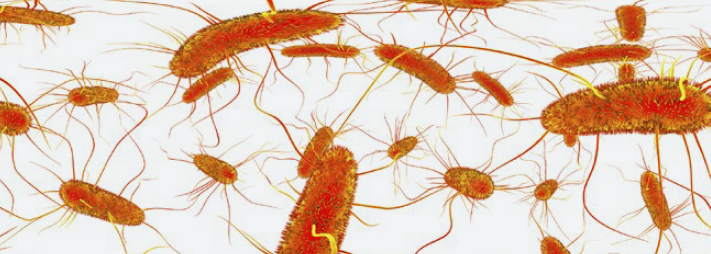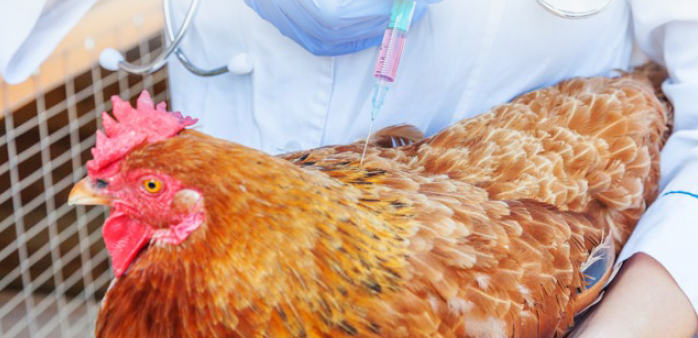
Prevention and contol of Salmonellosis:
The most important species of Salmonella affecting poultry production can be devided into two large groups.
1. Host-adapted and non-motile species as S. enterica serovar Pullorum (SP)/ Gallinarum (SG), have been mostly eradicated in developed countries. Although identified as a single serovar, they are genetically and biochemically different.
2. Paratyphoid. The most important group which includes dozen of species, mostly mobile. They represent a serious problem for animal and public health.
Usually, infections occur asymptomatically and the immune response is limited in young birds that become carriers.

The complexity of the origin of infections caused by this group has caused several poultry sectors to make a joint effort for their prevention and control. The reaction of genetic companies and processing plants has been to produce contamination-free breeding birds, eggs and meat.
PATHOGENY
The pathogenesis of paratyphoid is divided into two phases called intestinal and systemic.
In the gastrointestinal tract, after oral ingestion, Salmonella has to survive in the presence of acidic pH in the first portion of the digestive system before reaching the intestines where the pH (less acidic) is more favorable for its growth.
Once in the cecum, it adheres to the cells of the intestinal epithelium and is located intracellularly for better bacterial replication. In response to the infection, the bird produces macrophages that ingest the bacteria present in the intestinal wall, which represents the beginning of the systemic phase.
After phagocytosis, the pathogen can survive inside white blood cells, multiply in the blood and spread to internal organs such as the liver and spleen. The typical immune response that is successful in the presence of other bacteria is not very effective in the case of these infections.
HOW TO PREVENT AND TREAT INFECTION
The first thing to consider in a prevention program is to determine the origin of the infection and what species are present.
It is necessary to identify whether the source is a feed ingredient, contaminated personnel or equipment, the presence of vectors, or transovarian (vertical) transmission. If we do not know the origin, it will be difficult to take the appropriate measures.
Most experts in the area consider that ideally at least two prevention methods should be used. This combination must include strict biosecurity. Next, we will review the most frequently used prevention and treatment methods.
Applied in treatment and prevention. Their great limitation is that they are not capable of permanently eliminating the infection and the birds become carriers.
The reality is that the pathogen is not detected in feces, because it is located inside the internal organs, waiting for the right moment (egg production peak, poor management, beak trimming or any type of stress) to reinfect the animals. An additional disadvantage is that it prevents the growth of the beneficial intestinal microflora.
Mostly used in prevention. Newborn chicks are more susceptible to infections caused by Paratyphoids. The older they become, the greater their resistance because they acquire a favorable intestinal microflora that protects them.
Competitive exclusion consists of a race to colonize the intestines with the appropriate microflora before pathogenic Salmonella invades. This approach has been used worldwide and is considered one of the most efficient in prevention.
Its effectiveness is the product of the combination of several mechanisms, including the production of volatile fatty acids, lower intestinal pH, development of local immunity, occupation of specific sites in the epithelial tissue, production of several antibacterial compounds and competition for nutrients.
They can be used both in treatment and prevention of infections. Pathogenic Salmonella species show a reduction in their growth rate when the pH of the environment drops below 5.
In the case of microorganisms that tolerate the presence of acids such as Lactobacillus, their growth is generally not affected. In general terms, acidifiers have two mechanisms of action.
Once the acids penetrate the interior of the bacteria, they dissociate and cause the pH inside to decrease. The bacteria react by bringing the pH to normal levels, but maintaining this process involves the consumption of more energy and eventually bacterial growth may stop and destruction may occur.
MEDIUM AND SHORT CHAIN FATTY ACIDS
The ban on antimicrobials has promoted the use of these acids to control Salmonella and other pathogens. Its mode of action differs from acidifiers because they don´t reduce the pH of the gastrointestinal tract.
The number of carbon atoms (C) in their composition varies and is used to classify them into short, medium or long chain fatty acids. The short chain contains less than 6 C and includes formic (1 C), acetic (2 C), propionic (3 C) and butyric (4 C). Medium chain fatty acids contain chains with 6-10 C and include caproic (6 C), caprylic (8 C) and capric (10 C). Long chain fatty acids have 14 C or more.
Food supplementation with short and medium chain fatty acids such as formic, propionic, butyric, caproic and caprylic have been associated in scientific studies with a lower degree of Salmonella isolation.
INACTIVATED AND LIVE VACCINES
Both types of vaccines, used alone or in combination, can significantly reduce the susceptibility of birds to infection with some types of Salmonella.
In the case of SE, several commercially available inactivated vaccines have demonstrated their effectiveness in reducing the level of intestinal colonization.
When bacterins are used, at least two doses must be applied during rearing to be effective. After application they generate a good humoral response that offers partial protection against invasion of internal organs and intestinal colonization, but they are not able to effectively protect in the case of very severe challenges. They are effective against the species a present in the vaccine, given that their level of cross protection is very low.

Live attenuated vaccines against SE have been widely used in commercial layers with good results. Unfortunately, the protection is short, only lasting between 30 and 60 days and it is necessary to revaccinate several times in growth to obtain good protection.
In conclusion, there is no single method that can prevent these infections and therefore there are several techniques that have been routinely used to prevent or treat infections caused by different species of Salmonella.
The control of Salmonellosis is and will continue to be an extremely important and complex issue from the point of view of poultry production and public health.
Subscribe now to the poultry technical magazine
AUTHORS

Layer Longevity Starts at Rearing
H&N Technical Team
The Strategy for a Proper Infectious Bronchitis Control
Ceva Technical Team
Elevate Hatchery Performance with Petersime’s New Data-Driven Incubation Support Service
Petersime Technical Team
Maize and Soybean Meal Demand and Supply Situation in Indian Poultry Industry
Ricky Thaper
Production of Formed Injected Smoked Chicken Ham
Leonardo Ortiz Escoto
Antimicrobial Resistance in the Poultry Food Chain and Novel Strategies of Bacterial Control
Edgar O. Oviedo-Rondón
GREG TYLER INTERVIEW
Greg Tyler
Insights from the Inaugural US-RSPE Framework Report
Elena Myhre
Newcastle Disease: Knowing the Virus Better to Make the Best Control Decisions. Part II
Eliana Icochea D’Arrigo
Avian Pathogenic E. coli (APEC): Serotypes and Virulence
Cecilia Rosario Cortés
The Importance of Staff Training on Animal Welfare Issues in Poultry Industry
M. Verónica Jiménez Grez
Rodent Control is a Key Factor in Poultry Biosecurity and Sustainability
Edgar O. Oviedo-Rondón